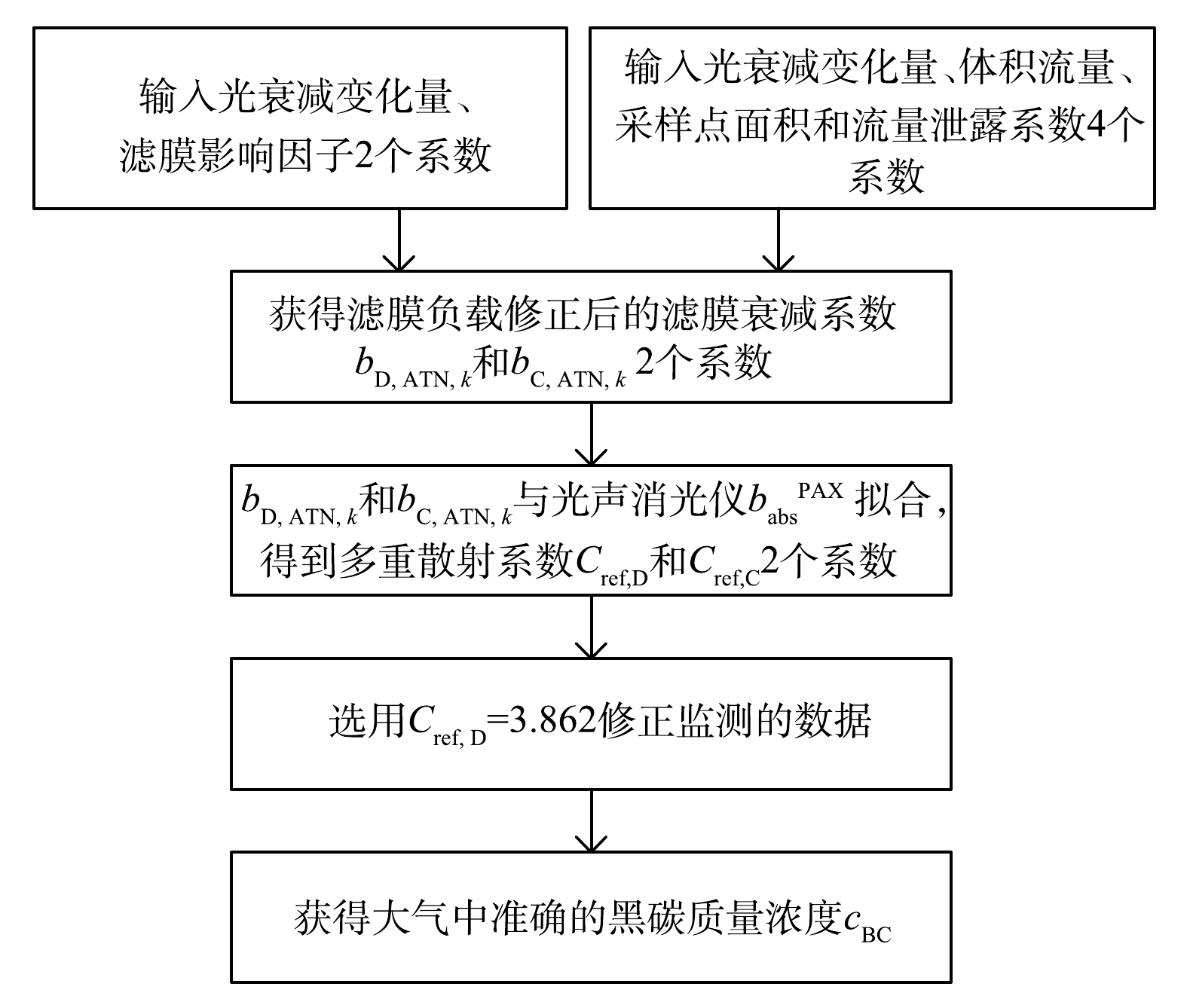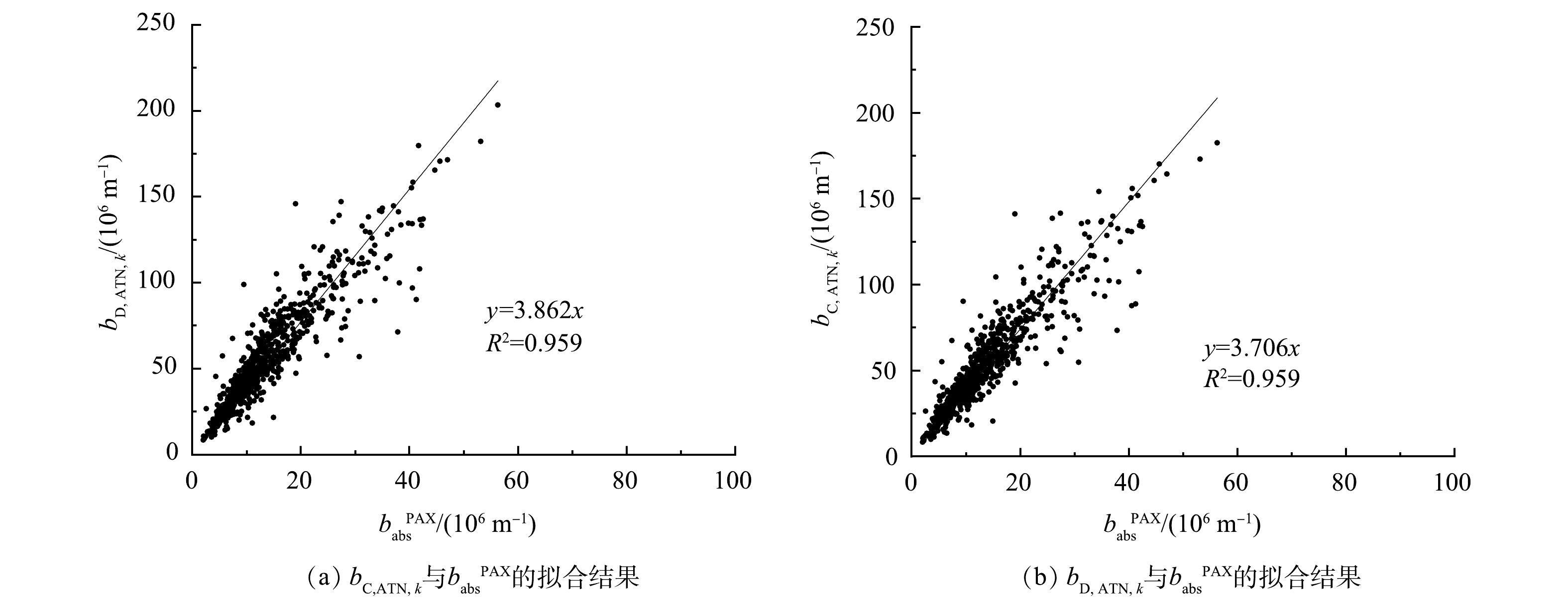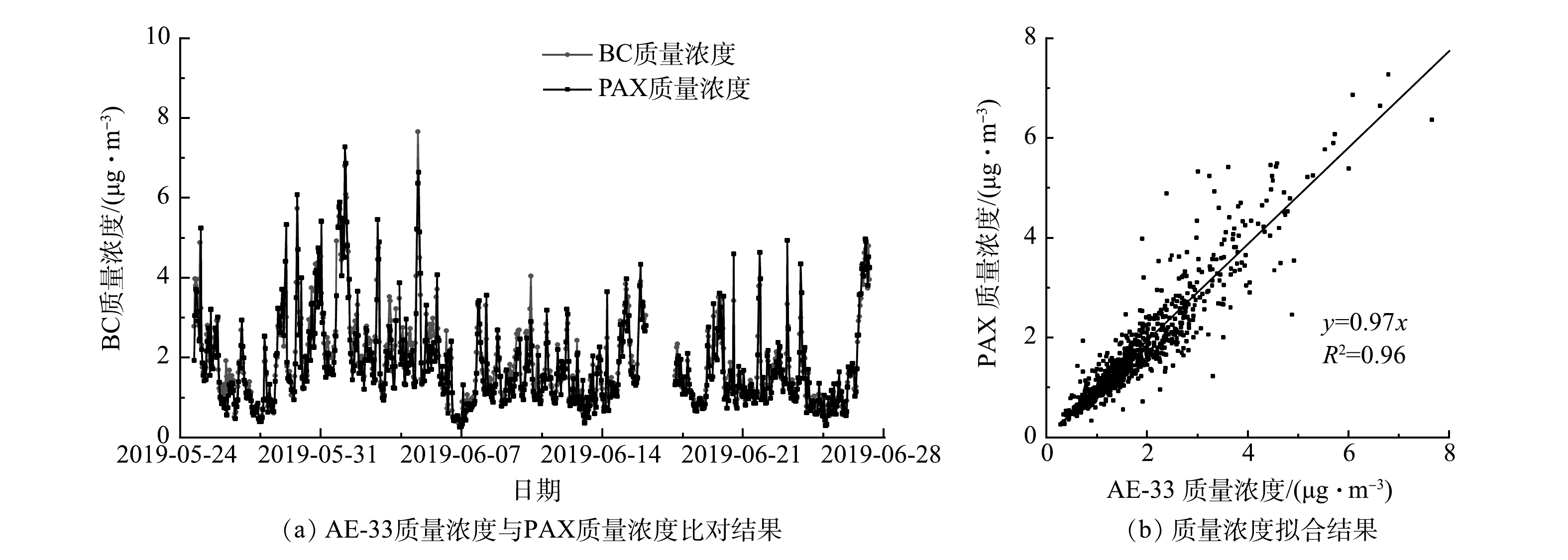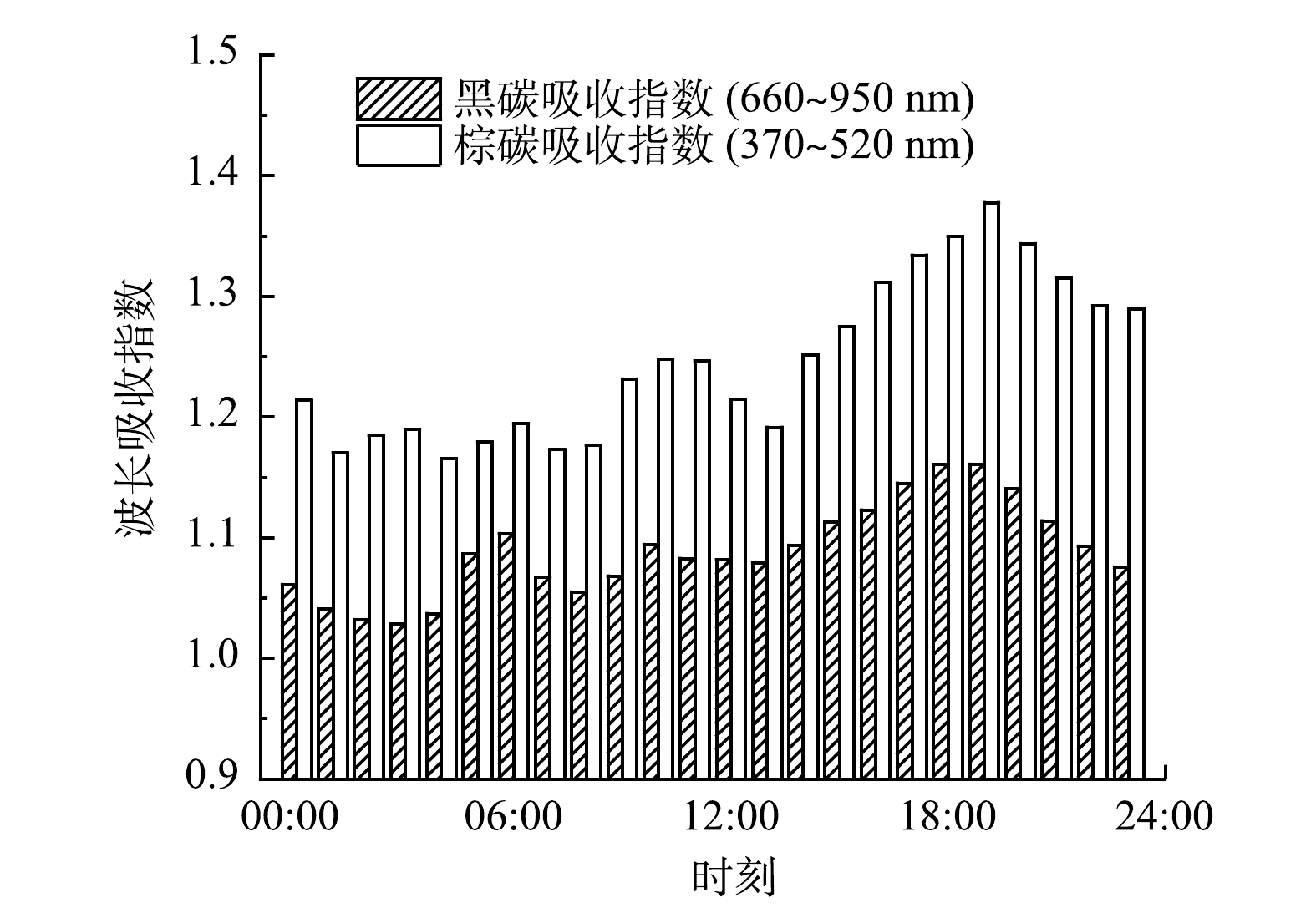-
生物质和化石燃料在缺氧情况下不完全燃烧产生的黑碳,在地球气候系统中具有独特而重要的作用。因为大气中所含的黑碳会吸收太阳辐射,影响地气系统能量交换,并加快冰雪的融化速度[1-2]。黑碳质量浓度过大会显著影响地区内硫酸盐的冷却效果[3],降低大气能见度[4],直接或间接影响着气候的变化。为应对当前的全球气候变化,我国作出了“2030年碳达峰、2060年碳中和”的承诺[5],因此,目前对黑碳的光学性质的测量及表征具有重要的现实意义。
黑碳(BC)的光学性质比较复杂,为了准确测量大气中真实BC含量, 国内外学者也提出了多种测量方法[6-12]。测量黑碳质量浓度方法主要分为滤膜法和原点位方法[13-14]。目前,滤膜法测量仪器包括滤膜式黑碳仪(AE-33)[15]、OC/EC分析仪等。原点位方法测量仪器包括光声消光仪(PAX)[16]、单颗粒黑碳光度计(SP2)[17]和腔衰减相位移反照射率监测仪(CAPS)[18]。黑碳仪作为最常用的仪器,具有操作简单、便于维护且不受外界气体干扰的优点,但其准确性受到滤膜负载效应和滤膜多重散射效应的影响。以往的研究仅仅局限于使用经验公式计算滤膜负载系数和滤膜多重散射系数[6-11],因此,如何选用准确的技术路线来监测大气中黑碳的质量浓度成为目前的研究焦点。
本研究以常州市滆湖地区为例,在已有研究[10-11]的基础上,使用2种经验公式进行滤膜负载修正系数的计算,然后对滤膜负载修正后的滤膜衰减系数进行拟合,并分析3种波长下的拟合系数;在拟合系数较好的基础上,以PAX作为参考仪器,对滤膜负载修正后的滤膜衰减系数和PAX测量的吸收系数进行拟合,得到多重散射系数Cref。修正后的监测技术路线可以正确地监测大气中黑碳的质量浓度。本研究以常州市滆湖地区监测数据为代表,可为监测区域黑碳气溶胶的管理提供参考。
-
本次监测站点位于江苏省常州市滆湖地区(31°48′N,119°58′E)。常州市地处长三角中心带,属于亚热带季风气候。滆湖位于常州市西南方向,周边60%是生态湿地、绿化园林,20%是水域。周边无明显污染源排放及高层建筑群,能够较好地代表长三角梅雨季前的区域大气状况。该地区属于城郊地区,是PM2.5和臭氧的传输通道,将采集点设置在这里,可以捕捉污染过程,更好地反映长三角地区大气污染情况。
-
本次实验选用黑碳仪(AE-33)和光声消光仪(PAX) 2台测量仪器。黑碳仪(AE-33,Magee Scientific)的测量原理为:AE-33通过样本与空白点的光衰减来得到气溶胶吸收系数, 从滤带上光的衰减量的变化率确定样品中黑碳的含量,仪器进样流量为5 L·min−1;光声消光仪(PAX,Droplet Measurement Technologies,Inc.)的测量原理为:PAX通过外置采样泵将气溶胶以1 L·min−1的流量引入到仪器中的积分浊度计和光声池之中,分别测量气溶胶的光散射和吸收系数。
-
黑碳仪(AE-33)滤膜多重散射效应一般大于颗粒物散射效应[7],因此,有关的研究的焦点大多在滤膜多重散射效应和滤膜负载效应的修正上。滤膜多重散射效应是指滤膜上的纤维以及颗粒物的光散射作用导致滤膜的光衰减增加;滤膜负载效应也称颗粒物遮蔽效应,是指随着滤膜负载积累的程度的加深,颗粒物相互间的遮挡使部分颗粒物没有被照射到,导致测量光衰减的减少。黑碳仪吸收系数和滤膜衰减系数计算方法见式(1)和式(2)。
式中:
$ {b}_{\mathrm{a}\mathrm{b}\mathrm{s},n}\left({\textit{λ}} \right) $ 为第n次仪器测量值的气溶胶吸收系数,106 m−1;$ {b}_{\mathrm{A}\mathrm{T}\mathrm{N},n}\left({\textit{λ}} \right) $ 为第n次仪器测量值的气溶胶衰减变化量,106 m−1;$ {{\Delta }b}_{\mathrm{A}\mathrm{T}\mathrm{N}1,n}\left({\textit{λ}} \right) $ 为测量点位1第n次仪器测量值的各波长在Δt时间内的光衰减变化量;S为采样点面积;$ {F}_{1,n} $ 为测量点位1第n次仪器测量值的体积流量;$ \text{ζ} $ 为流量泄露系数;100为光衰减原始定义的系数常数;Cref为多重散射系数;R为滤膜负载系数;Δt为第1次测量点位和第2次测量点位间隔时间,s。 -
由于黑碳仪测量装置不能直接反映悬浮状态下的气溶胶粒子的原有光学性质,因此,本研究采用COEN等[10]和DRINOVEC等[11]的经验公式,先计算滤膜负载系数,用来修正滤膜衰减系数,再进行多重散射效应系数的修正。首先对滤膜负载系数进行修正——计算2种经验公式下,滤膜负载修正后的滤膜衰减系数,并进行拟合;其次在拟合系数较好的情况下,对多重散射系数进行修正——参考同一时间段测量仪器光声消光仪的数据,在波长为532 nm处,将滤膜负载修正后的滤膜衰减系数与参照仪器测量的吸收系数进行拟合,得出2种方法下的多重散射系数,进而对修正后数据进行详细分析。黑碳监测技术改进方法见图1。
-
根据AE-33型黑碳仪监测气溶胶吸收系数的最终推导公式,其中涉及的滤膜负载系数的经验公式见式(3)和式(4)。式(3)为COEN等[10]的经验公式,式(4)为DRINOVEC等[11]的经验公式。
式中:bATN,n为第n个测量值的光衰减变化量(减去原始光衰减bATN,0);RC,n为第n个测量值的滤膜负载补偿系数;f为滤膜负载影响因子;滤膜负载影响因子使用文献中的系数[19],选用f=1.13来表征城市污染物对黑碳仪(AE-33)的影响因子;RD,n为第n个仪器测量值的滤膜负载参数;kD为第n个仪器测量值的影响因子。
本研究使用黑碳仪(AE-33)测量7个波长中的3个波长(520、660和880 nm)处未修正的数据,分别使用COEN等[10]和DRINOVEC等[11]的经验公式,重新计算得到滤膜负载修正后的滤膜衰减系数bC,ATN,k和bD,ATN,k。
由图2可以看出,bC,ATN,k和bD,ATN,k 的比对结果在520 nm波长处的线性拟合斜率为0.948,拟合系数R2为0.988;在660 nm波长处的线性拟合斜率为1.011,拟合系数R2为0.988;在880 nm波长处的线性拟合斜率为1.062,拟合系数R2为0.985。拟合系数都在0.98以上,说明使用2种经验公式后,滤膜负载修正后的滤膜衰减系数数值基本一致,因此, COEN等[10] 和DRINOVEC等[11] 的经验公式均具有较高的可行性。
如图2所示,在520、660和880 nm下,随着波长的增加,其拟合斜率也在增加。其原因推测为DRINOVEC等[11]的计算方法中的负载影响因子k值具有波长依赖性[20]。取仪器各个波长的平均值k(表1),可以看出,随着波长的增大,其滤膜负载的影响因子k越来越小。这说明影响因子k在短波长依赖性较强,在长波长依赖性较弱[6,11]。
-
在使用黑碳仪进行外场监测的过程中,多重散射效应系数的理想确定方法是使用同一点位监测参照仪器进行比对[20-21]。由于参照仪器PAX测量波长为532 nm,而黑碳仪(AE-33)缺少波长532 nm,故需要手动进行计算。计算方法如式(5)所示。
式中:Cref为多重散射系数;bD,ATN,k(λ532 nm)为使用DRINOVEC等[11]的方法计算得到滤膜负载修正后的滤膜衰减系数;babsPAX(λ532 nm)为参照仪器PAX的吸收系数。
已知黑碳仪(AE-33)仪器波长为520 nm,而式(5)中使用的波长为532 nm,因此,参照文献中的方法[21-22],采用520 nm与590 nm处滤膜负载修正后的滤膜衰减系数,推导波长为532 nm处的滤膜衰减系数,计算方法见式(6)和式(7)。
式中:bD,ATN,k(λ520 nm)为使用DRINOVEC等[11]的方法计算得到波长为520 nm处滤膜负载修正后的滤膜衰减系数;α520~590 nm为波长520~590 nm下的修正因子。
在相同波长为532 nm处,滤膜负载系数修正后的滤膜衰减数系数bD,ATN,k与相邻放置的光声消光仪测量的气溶胶吸收系数babsPAX进行比对,可以确定黑碳仪的多重散射效应增强参数Cref。
由图3可以看出,使用COEN等[10]的方法进行滤膜负载修正后的滤膜衰减系数 bC,ATN,k,与气溶胶吸收系数babsPAX监测数据进行比对,可以得出多重散射系数Cref,C为3.706;使用DRINOVEC等[11]的方法进行滤膜负载修正后的滤膜衰减系数 bD,ATN,k,可以得出多重散射系数Cref,D为3.862。与LAING等[20]和ZHAO等[21]的研究结果Cref,L为4.35和Cref,Z为2.9相比,本研究得出的多重散射效应系数Cref,C为3.706和Cref,D为3.862介于两者之间。因此,可认为本研究中计算的多重系数系数是正确的。其中修正后的多重散射系数没有波长依赖性,可以适用于所有波长[12]。
-
在监测期间中,将黑碳仪(AE-33)在同一时间段内的监测数据与同一监测点内的气溶胶光声光谱仪(PAX)数据进行比对测量。PAX仪器的黑碳质量浓度的计算方法见式(8)。
式中:babs为气溶胶光声光谱仪直接监测的气溶胶吸收系数,106 m−1;σBC为不同波长下的质量吸收截面数值(使用仪器自身校准结果得出的质量吸收截面),m2·g−1;cBC为黑碳的质量浓度,μg·m−3。
如图4(a)所示,黑碳仪(AE-33)和光声光谱仪(PAX) 2台仪器监测的气溶胶质量浓度的变化趋势一致,高低值也在同一时间段出现;如图4(b)所示,拟合数据中拟合斜率为0.97,拟合系数R2为0.96,比对后的数据与PAX监测的数据之间存在3%的细微偏差。这是因为:第一,2台仪器的监测方法不同,AE-33监测方式为滤膜法,PAX的监测方式为光声法,在长周期监测中,可能存在目前不可修正的数据点位;第二,滤膜负载系数采用DRINOVEC等[11]的方法得到,故推测偏差与影响因子k值的波长依赖性有关[20]。
-
波长吸收指数(
$ {a}_{\mathrm{A}\mathrm{b}\mathrm{s}} $ ) 是表征气溶胶吸收的重要参数之一,是体现气溶胶吸收贡献随波长变化规律的重要光学性质参数。气溶胶波长吸收指数越高,说明其吸收作用的光谱依赖性越强。吸收波长指数的近似值$ {a}_{{\lambda}1{\text{~}}{\lambda} 2} $ 计算方法[22-23]见式(9)。式中:babs(λ1)为波长
$ {\lambda}_{\text{1}} $ 处气溶胶吸收系数,106 m−1;babs(λ2)为波长$ {{\lambda }}_{\text{2}} $ 处气溶胶吸收系数,106 m−1;此处波长λ1小于波长λ2.有研究[24-25]表明,靠近交通源排放的BC,吸光度对光谱依赖性比较低,
$ {a}_{\mathrm{A}\mathrm{b}\mathrm{s}} $ 的值大概在1左右,生物质的燃烧排放BC光谱依赖性比较高,$ {a}_{\mathrm{A}\mathrm{b}\mathrm{s}} $ 通常大于2。也有研究[26]将BC归类于生物质燃料和化石燃料,并用$ {a}_{\mathrm{A}\mathrm{b}\mathrm{s}} $ 的值为1或2来判断当地污染物的来源。黑碳BC主要对590 nm以上的波长有贡献,高于590 nm波长的棕碳(BrC)的吸收系数可以忽略不计[27]。在4个波长下的光声光谱仪监测数据表明:532 nm波长以下,棕碳(BrC)光吸收能力强;在660 nm以上,黑碳(BC)的光吸收能力强[28]。因此,黑碳选择波长为660~950 nm,棕碳选择波长为370~520 nm。对于修正后的数据,进一步讨论当地污染源排放的问题。棕碳$ a $ 370~520 nm的平均值为1.247, 黑碳$ a $ 660~950 nm的平均值为1.089,由此可判断BC的排放源主要是靠近交通源的排放。黑碳$ a $ 660~950 nm小于棕碳$ a $ 370~520 nm,表明当地气溶胶含量中BrC大于BC。由图5可以看出,棕碳的吸收指数大于黑碳的吸收指数,棕碳BrC对大气的吸收贡献占主导地位。有研究[29]表明,棕碳在大气中的吸收贡献作用不可忽略。本研究的监测数据表明:2个波长吸收指数变化趋势基本都呈凌晨低、午后高的趋势;早晨波长吸收指数偏低。有研究者[30]推测,这与粒子老化有关;而对于总体趋势的变化,有研究[26]表明,可能与气溶胶化学组分有关。由图(5)可以看出,波长吸收指数出现高低值时刻:10:00—11:00出现高值,这与人流稠密度有关;13:00出现低值,这可能与大气层的边界层高度增加有关;19:00出现高值,这可能与交通源排放相关。
-
棕碳的污染来源可能为一次和二次排放,因此,确定一次棕碳和二次棕碳对大气的吸收贡献是非常有必要的[31]。但是,直接测得二次棕碳的吸收贡献方法鲜有报道,因此,本研究采用间接的方法去推导二次棕碳的吸收贡献。
有研究[32-34]表明,在较长的波长下,可以假设BrC的吸收系数有零吸收的现象。因此,本研究假设BrC在950 nm处没有吸收贡献,即在所有波长中减去BC的吸收贡献,剩下的吸收贡献值则认为是 BrC引起的吸收贡献。同时,本研究认为波长为370~950 nm时,黑碳和棕碳是主要的吸光物质,且假设没有其他吸光物质(碳酸盐、可吸入粒子和飘尘等)存在。WANG等[35-36]使用最小二乘法(MRS)计算出了一次排放时,吸收系数与质量浓度的比值。该算法的前提是在880 nm处,视黑碳BC物质为唯一吸光物质,计算方法见式(10)和式(11)。
式中:
$ {b}_{\mathrm{a}\mathrm{b}\mathrm{s}}^{\mathrm{B}\mathrm{r}\mathrm{C},\mathrm{s}\mathrm{e}\mathrm{c}}\left({\textit{λ}} \right) $ 为二次棕碳吸收系数,106 m−1;$ {b}_{\mathrm{a}\mathrm{b}\mathrm{s}}\left({\textit{λ}} \right) $ 为λ波长下的吸收系数,106 m−1;$\left(\dfrac{{b}_{\rm{abs}}\left({\textit{λ}}\right)}{{c}_{\rm{BC}}}\right)_{\rm{Pri}}$ 为一次排放时babs(λ)与cBC 的比值; cBC为BC质量浓度,μg·m−3。图6(a)反映了波长为370、470、520、590、880和950 nm时,babs(λ)每天的变化的情况。波长370 nm处吸收系数为7.65
$ \times $ 106~60.47$ \times $ 106 m−1;波长950 nm处吸收系数为2.58$ \times $ 106~18.00$ \times $ 106 m−1。波长为370 nm时变化相对而言比较大,故本研究选择波长为370 nm来进行研究。由图6(b)可以看出,在波长为370 nm处,二次棕碳吸光贡献占比大于一次棕碳的吸光贡献。 二次棕碳主要来源于二次气溶胶排放,一次棕碳主要来自于一次气溶胶排放[31]。因此可以推测,监测地点以二次棕碳污染为主,二次气溶胶排放量较多,这与ZHU等[37]的研究结果中二次棕碳占主导的观点是一致的。黑碳、一次棕碳和二次棕碳的吸收系数随着时刻的不同,也在发生变化。吸收系数数值较低时,机动车经过较少,导致监测值偏低[38]。气候、温度通过改变云层的厚度来影响碳质气溶胶光学性质的变化[36]。与此同时,取样地点的燃烧源(生物质燃烧,煤燃烧,交通污染)不同,也会影响着黑碳、一次棕碳和二次棕碳的吸收贡献值[31]。
-
1) 结合经验公式并参照PAX仪器监测的数据比对,修正后的监测数据结果表明:在波长为520、660和880 nm时,拟合系数R2分别为0.988、0.988和0.985;2台仪器监测的数据经过拟合后,多重散射系数Cref,C 为3.706,多重散射系数Cref,D为3.862。由于多重散射系数Cref在允许范围内(2.9~4.35),说明改进后的黑碳监测技术路线具有适用性。
2) 在波长为532 nm处,修正后的黑碳仪质量浓度与参照仪器光声消光仪(PAX)质量浓度拟合系数较好(R2=0.96),说明本研究提出的黑碳监测技术方法具有可行性。
3) 依据修正后的黑碳仪数据,分析BC和BrC对常州地区的吸光贡献。结果表明,棕碳吸收指数(1.247
$ \times $ 106 m−1)高于黑碳吸收指数(1.089$ \times $ 106 m−1),二次棕碳(2.81$ \times $ 106~22.94$ \times $ 106 m−1)高于一次棕碳(0.81$ \times $ 106~5.63$ \times $ 106 m−1)。说明常州市主要污染来源于交通源排放,二次棕碳占有主导位置。
大气黑碳监测技术改进及系数修正——以常州市滆湖地区监测数据为例
Atmospheric black carbon monitoring techniques improvement and coefficient correction ——An example of observed data of Gehu area in Changzhou
-
摘要: 为准确监测大气中黑碳的质量浓度,提高监测数据的代表性和准确性,采用黑碳仪(AE-33)对常州市滆湖地区进行了监测;参照同一时间段另一台光声消光仪(PAX)仪器测得的数据并进行比对,以滤膜负载补偿系数和多重散射系数修正为基础,根据实际测量数据分析波长吸收指数(
$ {a}_{\mathrm{A}\mathrm{b}\mathrm{s}} $ )和二次棕碳占比情况。结果表明:当修正滤膜负载补偿参数时,在520、660和880 nm波长下,拟合系数R2分别为0.988、0.988和0.985,验证了使用2种修正经验公式计算滤膜负载系数的方法具有较高的可靠性;在此基础上,当修正多重散射系数Cref时,2台仪器测量的数据经过拟合得出多重散射系数的值分别为3.706和3.862;2台仪器的质量浓度拟合系数R2为0.96, 误差范围为3%;在常州地区,棕碳和黑碳,这2种物质的吸收指数接近1左右,由此可判断污染源均来自交通排放;一次棕碳与二次棕碳,这2种物质吸收贡献值相比,二次棕碳占主导地位,二次气溶胶的排放量大。综上所述,黑碳仪结合经验公式和数据比对的修正技术路线具有可行性和适用性,能准确测量大气中的黑碳质量浓度,并对环境污染状态做出正确评估。本研究结果可为大气黑碳气溶胶的监测和管理提供参考。Abstract: In order to accurately monitor the mass concentration of black carbon in the atmosphere and improve the representativeness and accuracy of the observed data, the aetholometer (AE-33) was used to monitor the Gehu area in Changzhou. In comparison with the data monitored by another photoacoustic extinction instrument(PAX) during the same period, the absorption Ångström exponent ($ {a}_{\mathrm{A}\mathrm{b}\mathrm{s}} $ ) and the proportion of secondary brown carbon were analyzed according to the actual measured data based on the filter membrane load compensation coefficient and multiple scattering coefficient correction. The results show that when the filter membrane load compensation parameters were modified, the fitting coefficients R2 were 0.988, 0.988 and 0.985 at 520, 660 and 880 nm wavelengths, respectively, which proved the high reliability of the two modified empirical formulas for calculating the filter membrane load coefficients. On this basis, when the multiple scattering coefficient Cref was modified, the values of the multiple scattering coefficient determined from the regression of measured data by the two instruments were 3.706 and 3.862, respectively. The fitting coefficient R2 of mass concentration of the two instruments was 0.96 and the error range was 3%. The absorption Ångström exponent of brown carbon and black carbon in Changzhou were close to 1, so it could be concluded that the pollution sources were from traffic emissions. Compared with and absorption contribution value of first and secondary brown carbon, secondary brown carbon played a dominant role and secondary aerosol emission was large. In conclusion, the modified technical route combined with empirical formula and data comparison is feasible and applicable, which can accurately measure the mass concentration of black carbon in the atmosphere and correctly evaluate the state of environmental pollution .The results of this study can provide a reference for monitoring and management of atmospheric black carbon aerosols. -

-
表 1 滤膜负载影响因子k值随波长变化趋势
Table 1. Variation trend of k value of filter membrane load with wavelength
波长序号 波长/nm k的平均值 1 370 0.004 13 2 470 0.004 10 3 520 0.003 95 4 590 0.003 66 5 660 0.003 17 6 880 0.001 62 7 950 0.001 26 -
[1] BOND T C, D0HERTY S J, FAHEY D W, et al. Bounding the role of black carbon in the climate system: A scientific assessment[J]. Journal of Geophysical Research Atmospheres, 2013, 118(11): 5380-5552. doi: 10.1002/jgrd.50171 [2] SHRESTHA G, TRAINA S J, SWANSTON C W. Black carbon’s properties and role in the environment: A comprehensive review[J]. Sustainability, 2010, 2(1): 294-320. doi: 10.3390/su2010294 [3] CHYLEK P, VIDEEN G, NGO D, et al. Effect of black carbon on the optical properties and climate forcing of sulfate aerosols[J]. Journal of Geophysical Research, 1995, 100(D8): 16325-16332. doi: 10.1029/95JD01465 [4] 马志强, 赵秀娟, 孟伟, 等. 雾和霾对北京地区大气能见度影响对比分析[J]. 环境科学研究, 2012, 25(11): 1208-1214. [5] 李琴. 中国造船业碳减排路在何方[N]. 中国船舶报, 2021-03-19(005). [6] WEINGARTNER E, SAATHOFF H, SCHNAITER M, et al. Absorption of light by soot particles: determination of the absorption coefficient by means of aethalometers[J]. Journal of Aerosol Science, 2003, 34(10): 1445-1463. doi: 10.1016/S0021-8502(03)00359-8 [7] ARNOTT W P, HAMASHA K, MOOSMULLER H, et al. Towards aerosol light-absorption measurements with a 7-wavelength aethalometer: Evaluation with a photoacoustic instrument and 3-wavelength nephelometer[J]. Aerosol Science and Technology, 2005, 39(1): 17-29. doi: 10.1080/027868290901972 [8] SCHMID O, ARTAXO P, ARNOTT W P, et al. Spectral light absorption by ambient aerosols influenced by biomass burning in the Amazon Basin. I: Comparison and field calibration of absorption measurement techniques[J]. Atmospheric Chemistry and Physics, 2006, 6: 3443-3462. doi: 10.5194/acp-6-3443-2006 [9] VIRKKULA A, MAKELA T, HILLAMO R, et al. A simple procedure for correcting loading effects of aethalometer data[J]. Air & Waste Management Association, 2007, 57(10): 1214-1222. [10] COEN M C, WEINGARTNER E, APITULEY A, et al. Minimizing light absorption measurement artifacts of the aethalometer: Evaluation of five correction algorithms[J]. Atmospheric Measurement Techniques, 2010, 3(6): 457-474. [11] DRINOVEC L, MOCNIK G, ZOTTER P, et al. The "dual-spot" aethalometer: An improved measurement of aerosol black carbon with real-time loading compensation[J]. Atmospheric Measurement Techniques, 2015, 8(5): 1965-1979. doi: 10.5194/amt-8-1965-2015 [12] 蔡园青, 徐学哲, 周家成, 等. 黑碳仪测量气溶胶吸收系数的校正算法和影响因素研究进展[J]. 中国环境科学, 2021, 41(9): 4026-4035. doi: 10.3969/j.issn.1000-6923.2021.09.007 [13] MOOSMULLER H, CHAKRABARTY R K, ARNOTT W P. Aerosol light absorption and its measurement: A review[J]. Journal of Quantitative Spectroscopy and Radiative Transfer, 2009, 110: 844-878. doi: 10.1016/j.jqsrt.2009.02.035 [14] XU X Z, ZHAO W X, FANG B, et al. Three-wavelength cavity-enhanced albedometer for measuring wavelength dependent optical properties and single scattering albedo of aerosols[J]. Optics Express, 2018, 26: 33484-33500. doi: 10.1364/OE.26.033484 [15] 霍新峰, 欧阳俊. AE33七波段黑碳气溶胶分析仪维护浅析[J]. 分析仪器, 2021(3): 177-182. [16] NAKAYMA T, SUZUKI H, KAGAMITANI S, et al. Characterization of a three wavelength photoacoustic soot spectrometer (PASS-3) and a photoacoustic extinctiometer (PAX)[J]. Journal of the Meteorological Society, 2015, 93(2): 285-308. doi: 10.2151/jmsj.2015-016 [17] SCHWARZ J P, GAO R S, FAHEY D W. Single-particle measurements of midlatitude black carbon and light-scattering aerosols from the boundary layer to the lower stratosphere[J]. Journal of Geophysical Research, 2006, 111(D16): D16207. doi: 10.1029/2006JD007076 [18] PETZOLD A, ONASCH T, KEBABIAN P, et al. Intercomparison of a cavity attenuated phase shift-based extinction monitor (CAPS PMex) with an integrating nephelometer and a filter-based absorption monitor[J]. Atmospheric Measurement Techniques, 2013, 6(5): 1141-1151. doi: 10.5194/amt-6-1141-2013 [19] 张宇哲, 支国瑞, 靳文静, 等. 利用黑碳仪获取北京市冬季气溶胶吸光系数的方法研究[J]. 环境科学研究, 2019, 32(8): 1314-1323. [20] LAING J R, JAFFE D A, SEDLACEK A J. Comparison of filter-based absorption measurements of biomass burning aerosol and background aerosol at the Mt. bachelor observatory[J]. Aerosol and Air Quality Research, 2020, 20(4): 663-678. doi: 10.4209/aaqr.2019.06.0298 [21] ZHAO G, YU Y, TIAN P, et al. Evaluation and correction of the ambient particle spectral light absorption measured using a filter-based aethalometer[J]. Aerosol and Air Quality Research, 2020, 20(8): 1833-1841. doi: 10.4209/aaqr.2019.10.0500 [22] ÅNGSTRöM A. On the atmospheric transmission of sun radiation and on dust in the air[J]. Geografiska Annaler, 1929, 11(2): 156-166. doi: 10.1080/20014422.1929.11880498 [23] LACK D A, LANGRIDGE J M. On the attribution of black and brown carbon light absorption using the Ångström exponent[J]. Atmospheric Chemistry and Physics, 2013, 13(20): 10535-10543. doi: 10.5194/acp-13-10535-2013 [24] KIRCHSTETTER T W, NOVAKOV T, HOBBS P V. Evidence that the spectral dependence of light absorption by aerosols is affected by organic carbon[J]. Journal of Geophysical Research:Atmospheres, 2004, 9(D21): 1-12. [25] RUSSELL P B, BERGSTROM R W, SHINOZUKA Y, et al. Absorption angstrom exponent in AERONET and related data as an indicator of aerosol composition[J]. Atmospheric Chemistry and Physics, 2010, 10(3): 1155-1169. doi: 10.5194/acp-10-1155-2010 [26] SANDRADEWI J, PREVOT A S H, SZIDAT S, et al. Using aerosol light absorption measurements for the quantitative determination of wood burning and traffic emission contributions to particulate matter[J]. Environmental Science & Technology, 2008, 42(9): 3316-3323. [27] RATHOD T, SAHU S K, TIWARI M, et al. Light absorbing properties of brown carbon generated from pyrolytic combustion of household biofuels[J]. Aerosol and Air Quality Research, 2017, 17(1): 108-116. doi: 10.4209/aaqr.2015.11.0639 [28] AL F D, SMITH G D. A portable, four-wavelength, single-cell photoacoustic spectrometer for ambient aerosol absorption[J]. Aerosol science and technology, 2018, 52(4): 393-406. doi: 10.1080/02786826.2017.1413231 [29] CHOW J C, CHEN L W, WANG X L, et al. Improved estimation of PM2.5 brown carbon contributions to filter light attenuation[J]. Particuology, 2021, 56: 1-9. doi: 10.1016/j.partic.2021.01.001 [30] 武瑞东. 实验室内制备黑碳的光吸收及黑碳被有机物包覆后吸光增强效应的研究[D]. 济南: 山东大学, 2018. [31] LASKIN A, LASKIN J, NIZKORODOV, et al. Chemistry of atmospheric brown carbon[J]. Chemical Reviews, 2015, 115(10): 4335-4382. doi: 10.1021/cr5006167 [32] LU Z F, STREETS D G, WINIJKUL E, et al. Light absorption properties and radiative effects of primary organic aerosol emissions[J]. 2015, 49(8): 4868-4877. [33] KIRCHSTETTER T W, THATCHER T L. Contribution of organic carbon to wood smoke particulate matter absorption of solar radiation[J]. Atmospheric Chemistry and Physics, 2012, 12(14): 6067-6072. doi: 10.5194/acp-12-6067-2012 [34] SALEH R, ROBINSON E S, THACIK D S, et al. Brownness of organics in aerosols from biomass burning linked to their black carbon content[J]. Nature Geoscience, 2014, 7(9): 647-650. doi: 10.1038/ngeo2220 [35] WANG Q Y, HAN Y M, YE J H, et al. High Contribution of Secondary Brown Carbon to Aerosol Light Absorption in the Southeastern Margin of Tibetan Plateau[J]. Geophysical Research Letters, 2019, 46(9): 4962-4970. doi: 10.1029/2019GL082731 [36] WANG Q Y, YE J H, WANG Y C, et al. Wintertime optical properties of primary and secondary brown carbon at a regional site in the north China plain[J]. Environmental Science & Technology, 2019, 53(21): 12389-12397. [37] ZHU C S, QU Y, HUANG H, et al. Black carbon and secondary brown carbon, the dominant light absorption and direct radiative forcing contributors of the atmospheric aerosols over the tibetan plateau[J]. Geophysical research letters, 2021, 48(11): 1-9. [38] SINGH S, GOKHALE S. Source apportionment and light absorption properties of black and brown carbon aerosols in the Brahmaputra River valley region[J]. Urban Climate, 2021, 39: 1-12. -






 下载:
下载:



































